- Prelude
- Hard Talk
- New Media
- Rolex : An Overview
- The age of Revivals: Neoclassical Furniture
- Democratization of the Medium No-Budget film: the Indian Context (!)
- Old Sound New Sound
- Decan Odyssey
- North East Opsis
- Russian cool breeze in hot Paris
- Around Kolkata
- Musings from Chennai
- In and around Santiniketan
- In between – from Vadodra
- A Tryst with Art in Madhya Pradesh
- Through the Looking Glass
- The Foreign Connection
- Market Insight
- Market Report
- Artist Index and Statistics
- Auction Reports
- The month that was
- Delhi Dias
- Art Bengaluru
- Mumbai Art Sighting
- Creative Impulse
- Subodh Gupta
- Pooja Iranna
- Preview
- In the News
ART news & views
In the News
Volume: 2 Issue No: 9 Month: 10 Year: 2010
Meditation on religious tolerance
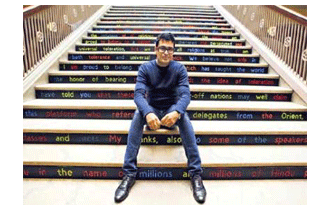 CHICAGO, IL: Acclaimed contemporary artist Jitish Kallat turns the landmark Art Institute Grand Staircase into a meditation on religious tolerance, drawing on the museums own history in concert with the most devastating terrorist attack on American soil. Public Notice 3, a site-specific installation, brings together two key historical moments: the first Parliament of the World's Religions, opening on September 11, 1893, in what is now the museum's Fullerton Hall, and the terrorist attacks on the World Trade Center and the Pentagon 108 years later, on that very date. Public Notice 3 the first major presentation of Kallat's work in an American museum will be on view September 11, 2010 through January 2, 2011.
CHICAGO, IL: Acclaimed contemporary artist Jitish Kallat turns the landmark Art Institute Grand Staircase into a meditation on religious tolerance, drawing on the museums own history in concert with the most devastating terrorist attack on American soil. Public Notice 3, a site-specific installation, brings together two key historical moments: the first Parliament of the World's Religions, opening on September 11, 1893, in what is now the museum's Fullerton Hall, and the terrorist attacks on the World Trade Center and the Pentagon 108 years later, on that very date. Public Notice 3 the first major presentation of Kallat's work in an American museum will be on view September 11, 2010 through January 2, 2011.
Provocative Art work creates controversy
Mumbai: Two "provocative" paintings by an Aurangabad-based artist Nandkumar Jogdand forced the Nehru Centre at Worli in Mumbai to discontinue the exhibition on Saturday, after running it for three days. 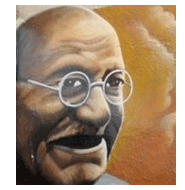 This is the first time the centre has abruptly stopped an art show. According to the artist this was a violation of his right to express himself, and that the trust-owned Nehru Centre had succumbed to pressure from a saffron group, a claim denied by the management. Assistant director of the Nehru Centre Art Gallery Nina Rege said the exhibits "were in bad taste and created controversy". The two paintings in question are titled 'Gandhi (After Pune Karar)' and 'Blind Faith'. The former depicts a dhoti clad Mahatma Gandhi striking a victim with a Trishul. The artist said he got the inspiration for this piece after reading the 'Pune Karar' or the Pune Pact, which happened after an agreement between Gandhi and Dr Babasaheb Ambedkar. In the second painting, 'Blind Faith', a nude Hindu goddess is depicted in a provocative position. Meanwhile, Nandkumar had sought police protection and demanded that the exhibition should run its full course.
This is the first time the centre has abruptly stopped an art show. According to the artist this was a violation of his right to express himself, and that the trust-owned Nehru Centre had succumbed to pressure from a saffron group, a claim denied by the management. Assistant director of the Nehru Centre Art Gallery Nina Rege said the exhibits "were in bad taste and created controversy". The two paintings in question are titled 'Gandhi (After Pune Karar)' and 'Blind Faith'. The former depicts a dhoti clad Mahatma Gandhi striking a victim with a Trishul. The artist said he got the inspiration for this piece after reading the 'Pune Karar' or the Pune Pact, which happened after an agreement between Gandhi and Dr Babasaheb Ambedkar. In the second painting, 'Blind Faith', a nude Hindu goddess is depicted in a provocative position. Meanwhile, Nandkumar had sought police protection and demanded that the exhibition should run its full course.
Promising Artist Award
Mumbai: ART India and Visual Arts Gallery (India Habitat Centre), IHC will award Rs. 1,50, 000/- to the winner of The Promising Artist Award 2010. The Promising Artist Award in its 6th year has the aim to encourage and support committed contemporary Indian artists. The Award is open to Indian nationals working with painting, sculpture, installations, video and/or performance. Their application process is open till 15th October 2010.
Tagore exhibition revisits Paris
New Delhi:  India will revisit a slice of history next year when it takes a specially curated show of paintings by Rabindranath Tagore to Paris after 81 years to mark his 150th birth centenary in 2011. Culture Secretary Jawahar Sircar said in the capital Sunday. "Argentinian poetess Victoria Ocampo had said to Rabindranath Tagore, who began painting rather late in life at the age of 60, that his art would sell. Tagore agreed to create a series of paintings for an exhibition in the mecca of art, Paris, in 1930," Several countries showed interest to organize this exhibition like USA, Germany and other European countries. But the intention is to revisit the land where Tagore's paintings first drew large attention and then take it to other places. This exhibition will contain the most comprehensive collection of Tagore's work till date.
India will revisit a slice of history next year when it takes a specially curated show of paintings by Rabindranath Tagore to Paris after 81 years to mark his 150th birth centenary in 2011. Culture Secretary Jawahar Sircar said in the capital Sunday. "Argentinian poetess Victoria Ocampo had said to Rabindranath Tagore, who began painting rather late in life at the age of 60, that his art would sell. Tagore agreed to create a series of paintings for an exhibition in the mecca of art, Paris, in 1930," Several countries showed interest to organize this exhibition like USA, Germany and other European countries. But the intention is to revisit the land where Tagore's paintings first drew large attention and then take it to other places. This exhibition will contain the most comprehensive collection of Tagore's work till date.
Unknown Perspective of Pablo Picasso
Austria: In cooperation with Tate Liverpool, the Albertina presents Pablo Picasso as a politically and socially committed artist, thereby questioning the common image of this genius of a century.  Assembling some two hundred exhibits from more than sixty international collections, the exhibition illustrates within a historical review and in chronological order how Picasso responded to the war and its atrocities in his art. The exhibition's scope ranges from Picasso as a history painter and his key motif of the Dove of Peace one of the most important symbols of hope and the most famous emblem of the Peace Movement to his still lifes, which contain subtle and hidden commentaries on global events, as well as hints of Picasso's political attitude. While the exhibition deals with Picasso's global role and art from the perspective of his support of the Communist Party and the Peace Movement in general, the focus of the presentation in Liverpool was on the artist's visit in Great Britain on the occasion of his participation in the Peace Congress in Sheffield in 1950. Vienna as a town located at the crossroads between the East and West after the Second World War, likewise offers itself as an ideal venue: in 1952 it hosted the World Peace Congress, whose poster showed Picasso's drawing of a dove surrounded by a circle of interlocking hands. This exhibition, co-organized by Tate Liverpool and the Vienna Albertina, will modify, expand, and probably revolutionize our hitherto common view of Picasso. Within this framework, the artist, who has mostly been perceived as an extrovert and womanizer, appears in a social and cultural context that has previously largely been ignored in the treatment of this painter, whose political side has systematically been shut out.
Assembling some two hundred exhibits from more than sixty international collections, the exhibition illustrates within a historical review and in chronological order how Picasso responded to the war and its atrocities in his art. The exhibition's scope ranges from Picasso as a history painter and his key motif of the Dove of Peace one of the most important symbols of hope and the most famous emblem of the Peace Movement to his still lifes, which contain subtle and hidden commentaries on global events, as well as hints of Picasso's political attitude. While the exhibition deals with Picasso's global role and art from the perspective of his support of the Communist Party and the Peace Movement in general, the focus of the presentation in Liverpool was on the artist's visit in Great Britain on the occasion of his participation in the Peace Congress in Sheffield in 1950. Vienna as a town located at the crossroads between the East and West after the Second World War, likewise offers itself as an ideal venue: in 1952 it hosted the World Peace Congress, whose poster showed Picasso's drawing of a dove surrounded by a circle of interlocking hands. This exhibition, co-organized by Tate Liverpool and the Vienna Albertina, will modify, expand, and probably revolutionize our hitherto common view of Picasso. Within this framework, the artist, who has mostly been perceived as an extrovert and womanizer, appears in a social and cultural context that has previously largely been ignored in the treatment of this painter, whose political side has systematically been shut out.
Museum for the first time showcases Contemporary Art
Mumbai: Dr. Bhau Daji Lad Museum presents 'This too shall pass' by Sudarshan Shetty. Sudarshan Shetty,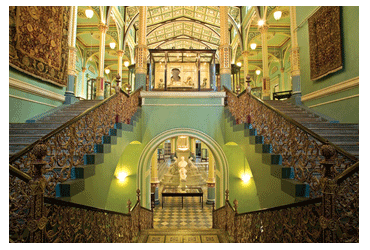 best known for his enigmatic and moving sculptural installations has long been recognized as his generation's most innovative conceptual artist in India. Though trained in painting at the Sir J.J School of art, he moved to installation early on in his career exploring the fundamental challenges presented by our immersion in a world of objects. Working with the mechanical animation of objects and the philosophical implications of the quest for mechanical life, Shetty draws on a terrain that centers on the social life of things and their capacities to offer new kinds of subjective experience. The exhibition is the first of a series of exhibitions planned by the Museum to re-establish its historic connection with the Sir J. J. School of Art. During the 19th and early 20th century the position of curator of the Museum and the principal of the School of Art were held by the same person. Many of the objects in the Museums were produced by students of the School. The Museum is a rich repository of the history and culture of the city. The exhibition series is planned as a residency where artists respond to the Museum's collection and engage with its history and archives.
best known for his enigmatic and moving sculptural installations has long been recognized as his generation's most innovative conceptual artist in India. Though trained in painting at the Sir J.J School of art, he moved to installation early on in his career exploring the fundamental challenges presented by our immersion in a world of objects. Working with the mechanical animation of objects and the philosophical implications of the quest for mechanical life, Shetty draws on a terrain that centers on the social life of things and their capacities to offer new kinds of subjective experience. The exhibition is the first of a series of exhibitions planned by the Museum to re-establish its historic connection with the Sir J. J. School of Art. During the 19th and early 20th century the position of curator of the Museum and the principal of the School of Art were held by the same person. Many of the objects in the Museums were produced by students of the School. The Museum is a rich repository of the history and culture of the city. The exhibition series is planned as a residency where artists respond to the Museum's collection and engage with its history and archives.
Peru Collective Connects Young Artists with Buyers
A three-day fair at an upscale hotel is showcasing the work of contemporary Peruvian artists to a growing legion of middle class art collectors and enthusiasts with money to spend. Desenfranquiciados Colectivo, curators of Peru's youthful, anti-establishment art scene, chose a luxury hotel for the event that aims to change the art market in Peru. The show features the work of 45 Peruvian artists, including photographs, paintings, sculptures, lithographs and illustrations, each on sale for $500 or less. "The goal of Desenfranquiciados is to make art more accessible to the public and to buyers as well as artists, particularly young artists," said Nicolas Figari, an abstract photographer and one of the collective's lead organizers. 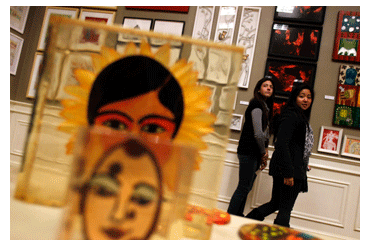 For the past two decades Lima's art world has been controlled by a small group of family-owned galleries with little interest in contemporary art, according to Figari. "It's run by 20 or 30 galleries and it's not easy for a young artist to get in. You have to have contacts and money. Desenfranquiciados is a really good way to get into the art market because we give everyone a shot," he said.
For the past two decades Lima's art world has been controlled by a small group of family-owned galleries with little interest in contemporary art, according to Figari. "It's run by 20 or 30 galleries and it's not easy for a young artist to get in. You have to have contacts and money. Desenfranquiciados is a really good way to get into the art market because we give everyone a shot," he said.
The collective was founded in 2004 by Figari's former teacher, Maria Elena Alvarado Boggio, a multimedia artist and instructor at the city's Centro de la Imagen. Alvarado hosted the first Desenfranquiciados exhibition in her apartment. Since she returned in 2008 after two years in New York, Desenfranquiciados has hosted about four art shows a year. "The idea was to show the works of artists who weren't in the gallery circuit, not for aesthetic reasons but for economic reasons. At the time commercial galleries were showing a lot of modernist work but there wasn't much interest in contemporary pieces, which perhaps were a bit more provocative," Alvarado explained. "The collective's success makes it clear that there is a market in Lima that wants to buy art but doesn't have the money to buy at the prices set by galleries." While galleries in Lima typically charge artists commissions up to 35 percent of the work's sticker price, artists who show with Desenfranquiciados receive all of the proceeds. For newcomers the show represents a unique opportunity to display work in a gallery setting and to mingle with collectors. Desenfranquiciados events also lure well-known artists whose work commands higher prices elsewhere. "The reason I participate is because it is easy to sell a bunch of work really fast," said Jaime Higa, a mixed-media artist and owner of Lima's Bruno Gallery. "In large part the movement has been fueled by the fact that more people are economically better off and can invest in younger artists," Higa explained.
Scorching Sun of Tibet
A row of young Tibetan artists stand in front of a towering sculpture of a traditional Tibetan religious object, a stupa. The shape was recognizable, but this stupa is made out of empty beer bottles. 
Tseten Kalsang is one of two brothers who created the beer bottle stupa. He says his artwork is about the dialogue between religion, tradition and modernity. He adds that Tibet's tradition already has been portrayed well, so he is trying to show how the modern world also has affected Tibetan culture. He says the beer bottle stupa is an example of how many cultural changes start with alcohol and food.
Another artist - long-haired, middle-aged Penpa - paints self-portraits. Sometimes naked figures are anguished, with eyes that reveal inner anxiety.
Penpa says many people think of Tibet as a backward place, with an art scene dominated by religious paintings known as thangkas. He says this exhibit has given Tibetan artists a chance to show the world that Tibet also has a thriving contemporary art scene, too.
The exhibit in Songzhuang, just outside Beijing, is called the Scorching Sun of Tibet.
Rare Antique of The Nizam of Hyderabad
Austin, Texas, United States, In a Feb. 22, 1937 cover story in Time magazine, Indian prince Jah VII, Mir Osman Ali Khan, The Nizam of Hyderabad was described as the richest man in the world, with a fortune of $2 billion.
Absolute ruler of 16 million people in the state of Hyderabad and the highest-ranking prince of India, His Exalted Highness established his own bank giant vaults would be required to hold all that royal loot and even issued his own currency: the Hyderabadi rupee. But far from mercenary, The Nizam was both a charitable and generous man whose financial contribution to Britain's war effort earned him the post-world war I title of “Faithful Ally of the British Crown.”
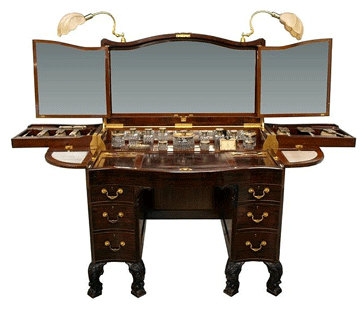 Within Osman Ali's diamond-studded inner circle, there was no limit to expenditure; only the best would do for his seven wives and 42 concubines. One of them, says Austin Auction Company's Chris Featherson, was quite likely the recipient of an extravagant furnishing that arrived recently at his company's Texas gallery for inclusion in a Sept. 26 sale. The circa-1930 triple-mirrored mahogany dressing table with fitted key-lock safe and 30-piece Art Deco vanity set of sterling silver and cut glass was entirely custom-made by the exclusive Goldsmiths & Silversmiths Co. Ltd. of London.
Within Osman Ali's diamond-studded inner circle, there was no limit to expenditure; only the best would do for his seven wives and 42 concubines. One of them, says Austin Auction Company's Chris Featherson, was quite likely the recipient of an extravagant furnishing that arrived recently at his company's Texas gallery for inclusion in a Sept. 26 sale. The circa-1930 triple-mirrored mahogany dressing table with fitted key-lock safe and 30-piece Art Deco vanity set of sterling silver and cut glass was entirely custom-made by the exclusive Goldsmiths & Silversmiths Co. Ltd. of London.
“We knew immediately from the quality of construction that it was something extraordinary, but after intensive research and consultation with an expert in India, we concluded that this dressing table was almost certainly commissioned by the prince,” said Featherston.
The tipoff was in plain sight on every piece in the vanity set. “An Islamic star and crescent moon symbol and one of three portraits of Osman Ali appear on each of the hairbrushes, jars, bottles, nail files even on the 8-day clock,” said Featherston. “We were able to identify the prince through photo matches. Also, in one of the portraits there's a distinctive jeweled turban ornament that only The Nizam was allowed to wear.”
Purchased by the present owner in the 1990s in Asia, the dressing table is expected to make $20,000 to $25,000 in Sunday's auction. “It could go much higher, though,” Featherston said. “To the people of India, this piece could well be regarded as an important treasure. It symbolizes the grandeur of India's royal past.”